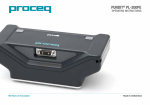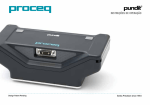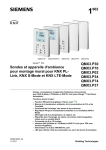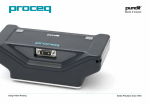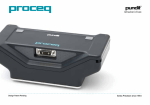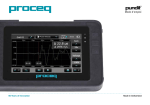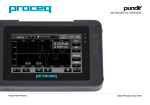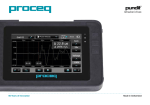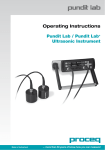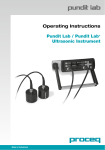Download Proceq Pundit PL-200PE Operating instructions
Transcript
Pundit® PL-200PE OPERATING INSTRUCTIONS 60 Years of Innovation Made in Switzerland Scope of Delivery A B D I C E J H A Pundit Touchscreen B Battery C Pundit Pulse Echo Transducer* D Pundit Pulse Echo Cable* E Pundit Pulse Echo Contact Tester* H Battery Charger I USB Cable J DVD with Software K Documentation L Carrying Strap *Part of the “Pundit Pulse Echo Transducer” package (Part No. 327 40 130) K L © 2013 Proceq SA 2 Overview Pundit PL-200PE 91 93 92 23 231 94 9 9 11 23 3 910 9 3.2 2 95 9 8 97 96 © 2013 Proceq SA Table of Contents 1. Safety and Liability....................................................... 5 1.1 General Information............................................................5 1.2Liability................................................................................5 1.3 Safety Instructions.............................................................5 1.4 Correct Usage....................................................................5 2.Technical Specifications............................................... 6 7. PL-Link Software........................................................ 14 7.1 7.2 7.3 7.4 7.5 Starting PL-Link................................................................14 Viewing the Data .............................................................15 Adjusting the Settings......................................................16 Exporting Data..................................................................16 Further Functions.............................................................17 3.Operation....................................................................... 6 3.1 Getting Started...................................................................6 3.2 Main Menu..........................................................................7 3.3Settings...............................................................................7 3.4 Measurement Screen.........................................................9 3.5 Measurement Modes.......................................................11 3.6 Measuring with Pundit PL-200PE....................................12 4.Explorer....................................................................... 13 5. Ordering Information.................................................. 13 5.1Units..................................................................................13 5.2Transducers......................................................................13 5.3Accessories......................................................................13 6. Maintenance and Support.......................................... 14 6.1Maintenance.....................................................................14 6.2 Support Concept.............................................................14 6.3 Warranty Information........................................................14 6.4Disposal............................................................................14 © 2013 Proceq SA 4 1. Safety and Liability 1.1 General Information This manual contains important information on the safety, use and maintenance of the Pundit PL-200PE. Read through the manual carefully before the first use of the instrument. Keep the manual in a safe place for future reference. 1.2 Liability 1.3 Safety Instructions The equipment is not allowed to be operated by children or anyone under the influence of alcohol, drugs or pharmaceutical preparations. Anyone who is not familiar with this manual must be supervised when using the equipment. • Carry out the stipulated maintenance properly and at the correct time. • Following completion of the maintenance tasks, perform a functional check. Our “General Terms and Conditions of Sales and Delivery” apply in all cases. Warranty and liability claims arising from personal injury and damage to property cannot be upheld if they are due to one or more of the following causes: 1.4 Correct Usage • Failure to use the instrument in accordance with its designated use as described in this manual. • Replace faulty components only with original replacement parts from Proceq. • Incorrect performance check for operation and maintenance of the instrument and its components. • Accessories should only be installed or connected to the instrument if they are expressly authorized by Proceq. If other accessories are installed or connected to the instrument then Proceq will accept no liability and the product guarantee is forfeit. • Failure to adhere to the sections of the manual dealing with the performance check, operation and maintenance of the instrument and its components. • The instrument is only to be used for its designated purpose as describe herein. • Unauthorised modifications to the instrument and its components. • Serious damage resulting from the effects of foreign bodies, accidents, vandalism and force majeure All information contained in this documentation is presented in good faith and believed to be correct. Proceq SA makes no warranties and excludes all liability as to the completeness and/or accuracy of the information. © 2013 Proceq SA 5 2. Technical Specifications 3. Operation Pundit PL-200 Range Pundit PL-200PE 0.1 – 7930 μs Resolution 0.1 μs (< 793 μs), 1 μs (> 793 μs) Display 7” colour display 800x480 pixels Pulse Voltage UPV UPE Bandwidth Receiver Gain Memory Regional Settings Battery Battery Lifetime Operating Temperature Humidity IP Classification Pulse Echo Range Transducer Frequency Aperture Size 6 100 – 450 Vpp – 100 – 400 Vpp The information provided in this manual covers the Pulse Echo application only. The Pundit PL-200PE also supports all functionality provided by the Pundit PL-200. It is necessary to purchase the BNC adapter cable (Part No. 327 01 049) for operation with standard P-wave transducers. A full listing of the standard transducers can be found on the Proceq website. The Pundit PL-200 operating manual is provided on the product DVD. 3.1 Getting Started Battery Installation 20 – 500 kHz 1x – 10’000x (0 – 80dB) [11 steps] To install the Battery (B) into the Pundit Touchscreen (A), lift the stand as shown. Insert the battery and fasten in place with the screw. Internal 8 GB Flash memory Metric and imperial units and multi-language supported Lithium Polymer, 3.6 V, 14.0 Ah > 8h (in standard operating mode) 0°C – 30°C (Charging, running instrument) 0°C – 40°C (Charging, instrument is off) -10°C – 50°C (Non-charging) < 95 % RH, non condensing IP54 0.1 – 1200 μs 50 kHz 2x25 cm2 There are three status LEDs 1 (see page page 3). The middle LED is red while charging and turns to green when fully charged. The other LEDs are application specific. NOTE! Only use the battery charger provided. © 2013 Proceq SA • A complete charge requires <9h (Instrument not operating.) • Charging time is much longer if the instrument is in use. • An optional quick charger (Part No. 327 01 053) can be used to charge a spare battery outside of the instrument. In this case it takes <4h for a complete charge. Connecting the transducer (D) Connect the Pulse Echo Transducer (C) to the Pundit Touchscreen (A) using the Pulse Echo Cable (D). Buttons Lift the protective visor. The upper right of the screen there are three buttons 2 (see page 3). Power On/Off – Press to power on. Press and hold to power off. Soft Key – Switches in and out of full screen view. Back Button – Returns to previous screen. 3.2 Main Menu On start up the main menu is displayed. All functions may be accessed directly via the touchscreen. Return to the previous menu by pressing the back button or the return icon (arrow) at the top left of the touchscreen. © 2013 Proceq SA Measurement: Application specific measurement screen. Settings: For application specific settings. Explorer: File manager functionality for reviewing measurements saved on the instrument. System: For system settings, eg. language, display options Information: For device information. Exit: Power Off. 3.3 Settings Scroll up and down the screen by dragging your finger up or down the screen. The current setting is displayed on the right hand side. Tap on an item to adjust it. Transducer Connected Transducer If a Pulse Echo Transducer is connected this will be recognized automatically. Test Transducer Each individual dry contact transducer can be tested for correct functionality. The graphic on the right hand side of the screen indicates which transducer pair is to be tested (blue highlight). Press the Pulse Echo Contact Tester (E) onto the transducer pair as shown. 7 A successful test is indicated by the transducer pair being highlighted green. The next pair to be tested is then highlighted blue. Continue until each transducer pair has been tested. Units Choose between metric and imperial units Echo Tracking When Echo Tracking is activated, the main echo is highlighted white in the A-Scan on the measurement screen. This is particularly useful if a quick read-out of slab thickness is desired. B-Scan For complex objects containing internal defects, pipes and rebars it is recommended to perform a complete B-Scan for analysis of the object. Distance between measurements Filters Set the spacing between measurements. For good resolution images, a spacing of 1 cm is recommended. For a quicker initial scan a coarser spacing may be used, e.g. 2.5 cm corresponding to the spacing markers on the Pulse Echo Transducer. Filters are used to filter out unwanted noise, to make it easier to identify the correct echo. 2.5 cm • OFF – No filter is applied. The raw signal is displayed. • Narrow – Applies a narrow band filter to the received signal. • Normal – Applies a medium band filter to the received signal. • Wide – Applies a wide band filter to the received signal. The received signal is saved post-filtering, so it is not possible to alter the filter afterwards. It is best to experiment to find the optimum filter setting before carrying out the complete B-Scan. Envelope When this setting is activated it uses an envelope of the A-Scan to generate the B-Scan image. This can also help to generate a clearer B-Scan image. 8 © 2013 Proceq SA Original – Original signal is used to generate the B-Scan. 3.4 Measurement Screen The standard measurement screen is shown on page 3. All settings are directly accessible from the measurement screen. Zoom Zoom in by placing thumb and index finger together on the screen and spreading them apart. This can be used in both the horizontal and vertical directions when making a measurement. Rectified – Rectified signal is used to generate the B-Scan. Zoom out by placing thumb and index finger apart on the screen and pinching them together. Pan Pan the image from left to right by dragging. Envelope – Envelope signals is used to generate the B-Scan. Measuring screen controls (see page 3) 1 Filename: Enter the file name (limited to 15 characters) and press return. Saved measurements will be stored with this file name. If several measurements are made under the same file name, a suffix increments after each measurement. SAFT When activated, applies a Synthetic Aperture Focusing Technique to the raw data to produce a sharper image. SAFT uses path length and positioning information to correct the image. The quality of the final image is dependent on the spacing of the measurements. A 1 cm spacing is recommended in most cases. © 2013 Proceq SA 2 Measurement mode: Select the type of measurement to be carried out (see section “3.5 Measurement Modes”). 3 The top right hand corner of the display shows the current transducer selected, current time and the battery status. 4 Gain: Adjust the receiver gain, from 1x up to a maximum of 10 000x. 5 Voltage: Adjust the transmitter voltage. For best results, it is best to begin with low transmitter voltage and a low gain setting. Then increase until a stable signal level is achieved. Signal clipping should be avoided. 9 6 Continuous/Burst Transmission: Continues transmitting until the stop icon is pressed. Records a measurement as soon as a stable signal is detected. 7 Settings: Enter the settings menu. 8 Stop/Save (Right Button on Transducer): L R Stop the current measurement. Save the current measurement. Save the current series and continue the measurement. 9 Start/Snapshot (Left Button on Transducer): Begin the measurement. Save the current measurement as displayed on the screen and continue measuring. 10 10 Cursor ON/OFF Set the cursor position manually, by dragging it to the left or right. The trigger position may also be adjusted later on the saved waveform in the Explorer. 11 Automatic Estimation of Pulse Velocity Ideally the pulse velocity should be entered manually after having made a control measurement on an object of known thickness. If this is not possible, it is possible to estimate the pulse velocity directly on surface of the test object. Tap on this button and press the transducer against the surface to make a measurement. The surface velocity will be measured automatically and stored as the pulse velocity for subsequent B-Scan or distance measurements. © 2013 Proceq SA 3.5 Measurement Modes Transmission time The measured transmission time between the transmitter and receiver. Distance Enter the pulse velocity of the material under test or perform an “Automatic Estimation of Pulse Velocity” as described in the previous chapter. The result is the thickness of the slab or distance to the internal object (e.g. void, delamination) that is the source of the echo. Pulse Velocity Enter the thickness of the object under test. The result is the transmission time and pulse velocity of the material under test. B-Scan Provides a cross sectional image of the test object perpendicular to the scanning surface in the plane through which the individual A-scans have been collected. Press the start icon to begin or the left button on the transducer. Record the first measurement. If burst mode is selected this will be recorded automatically. The measurement may also be recorded by pressing the left button on the transducer. • The LED’s on the transducer provide a visual feedback when a measurement has taken place successfully. This is accompanied by an acoustic tone on the display device. The volume of the tone may be adjusted in system settings. • Move the transducers a distance ‘a’ to the next point of the scan. Make the second measurement and continue. • The current A-Scan is shown on the right hand side of the screen. • The current status of the B-Scan is shown on the main part of the screen. Press this icon or the right button on the transducer to save the current B-Scan. Press this icon or the right button on the transducer to continue the current B-Scan. Use this icon to delete the last measurement made. Press the to save the current series and reset the instrument for a new series. The spacing between A-Scans is entered in the “Settings” menu. Position the transducer at the starting position. © 2013 Proceq SA 11 3.6 Measuring with Pundit PL-200PE NOTE! Testing with Pulse Echo Technology requires in-depth knowledge of the test object and application characteristics. Proceq offers comprehensive ultrasonic training seminars imparting this knowledge as well as all functionalities and features of the Pundit instruments. Pundit PL-200PE users are recommended by Proceq to register for the Advanced Ultrasonic Tomography Applications training. Details can be found on the Proceq website. Preparation • Very few preparations are necessary when measuring with the Pulse Echo Transducer. • The dry-contact transducer means that acoustic coupling is ensured without the use of any couplant. • The contacts are sprung and can accommodate surface irregularities to a depth of 7 mm, so smoothing of the surface is also unnecessary. • For B-Scans a test grid should be drawn out on the surface. Alternatively Proceq provide a calibrated tape (Part No. 327 010 71) that can be stuck on the surface for the test and then removed afterwards. Calibration The most accurate results can be obtained if the instrument is calibrated for the material under test. Physical influences on the Measurement Effect of particle sizeb Inhomogeneities (e. g. aggregate particles, voids) in concrete influence the propagation of an ultrasound pulse. They will scatter the signal. The effect is very large if the size of the aggregate is equal to or larger than the wavelength of the ultrasonic signal. This influence is significantly reduced when the wavelength is at least twice as large as the aggregate size. It also follows that it is very difficult to detect an anomaly if it is smaller than half the wavelength. The Pulse Echo Transducer is a shear wave transducer with a frequency of 50 kHz. Assuming a typical pulse velocity of 2500 m/s, the wavelength is 50 mm. This means that anomalies smaller than 25 mm will be invisible. Effect of sample size The geometry of the object is very important for obtaining good results. • The maximum penetration depth depends on the quality of the concrete and also on the amount of rebars present. Typically the maximum transmission depth lies between 50 cm (19.7”) and 1m (39.4”). • Generally, the minimum lateral dimension should be two times the thickness of the object, or the depth of the anomaly you are trying to detect. The reason for this is that if the object is too narrow, reflections from the side walls will interfere with the echo from the rear wall. • This is done by performing a pulse velocity measurement on a section of the structure of known thickness. • Alternatively, if this is not possible the automatic estimation of pulse velocity as described in chapter 3.4. 12 © 2013 Proceq SA 4. Explorer 327 20 001 From the main menu select Explorer to review saved files. Pundit PL-200PE Consisting of: Pundit Touchscreen, Pundit Pulse Echo Transducer incl. cable, contact tester, battery charger, USB cable, DVD with software, documentation, carrying straps and carrying case 5.2 Transducers Tap on a saved file to open it. Return to the Explorer list by pressing the back button. To delete a file tap in the check box to the left of the file and delete it 5. Ordering Information 5.1 Units PART NO. DESCRIPTION 327 10 002 Pundit Touchscreen without transducers Consisting of: Pundit Touchscreen, BNC adapter cable, battery charger, USB cable, DVD with software, documentation, carrying strap and carrying case 327 10 001 Pundit PL-200 Consisting of: Pundit Touchscreen, 2 Transducers 54 kHz, 2 BNC cables 1.5 m, couplant, calibration rod, BNC adapter cable, battery charger, USB cable, DVD with software, documentation, carrying strap and carrying case © 2013 Proceq SA PART NO. DESCRIPTION 325 40 026S 2 Transducers 24 kHz 325 40 131S 2 Transducers 54 kHz 325 40 141S 2 Transducers 150 kHz 325 40 177S 2 Transducers 250 kHz 325 40 175S 2 Transducers 500 kHz 325 40 176 2 Exponential Transducers 54 kHz, incl. calibration rod 325 40 049 2 S-Wave Transducers 250 kHz, incl. couplant 327 40 130 Pulse Echo Transducer, incl. cable and contact tester 5.3 Accessories PART NO. DESCRIPTION 327 01 043 Carrying strap complete 325 40 150 Transducer holder complete 327 01 049 BNC adapter cable for Pundit PL-200 325 40 021 Cable with BNC-plug, 1.5 m (5 ft) 13 325 40 022 Cable with BNC-plug, 10 m (33 ft) 6.3 Warranty Information 710 10 031 Ultrasound couplant, 250 ml 325 40 048 Shear wave couplant, 100 g Each instrument is backed by the standard Proceq warranty and extended warranty options. 327 01 033 Battery complete 327 01 053 Quick charger 710 10 028 Calibration rod 25 µs for Pundit PL-200 710 10 029 Calibration rod 100 µs for Pundit PL-200 327 01 070 Snap Ferrite for BNC Adapter cable* 327 01 051 Pundit Pulse Echo Cable 327 00 027 Pundit Pulse Echo Contact Tester complete * In the case that receiving equipment within a radius of 10m suffers from interference, it is possible to order a ferrite to fit onto the BNC adapter cable. This serves to further reduce the electromagnetic radiation produced by the instrument. • • Electronic portion of the instrument: 24 months Mechanical portion of the instrument: 6 months 6.4 Disposal Disposal of electric appliances together with household waste is not permissible. In observance of European Directives 2002/96/EC, 2006/66/EC and 2012/19/EC on waste, electrical and electronic equipment and its implementation, in accordance with national law, electric tools and batteries that have reached the end of their life must be collected separately and returned to an environmentally compatible recycling facility. 7. PL-Link Software 7.1 Starting PL-Link 6. Maintenance and Support Locate the file “PL-Link Setup.exe” on your computer or on the CD and click on it. Follow the instructions on the screen. 6.1 Maintenance To guarantee consistent, reliable and accurate measurements, the instrument should be calibrated on a yearly basis. The customer may however, determine the service interval based on his or her own experience and usage. 6.2 Support Concept Make sure that the “Launch USB Driver install” tick is selected. The USB driver installs a virtual com port which is needed to communicate with the Pundit Touchscreen Unit. Proceq is committed to providing a complete support service for this instrument by means of our global service and support facilities. It is recommended that the user register the product on www.proceq.com to obtain the latest on available updates. 14 © 2013 Proceq SA Double click on the PL-Link Icon on your desktop or start the PL-Link via the start menu. Select one or more measurements and click “Download”. Click on “Next >”. When a Pundit Touchscreen Unit has been found its details will be displayed on screen. Click on the “Finish” button to establish the connection. The PL-Link starts with a blank list. 7.2 Viewing the Data Application settings The menu item “File – Application settings” allows the user to select the language and the date and time format to be used. Connecting to a Pundit Touchscreen Unit Connect the Pundit Touchscreen Unit to a USB port, then select the following icon to download data from the Pundit Touchscreen Unit. Measurement files stored on the device will be displayed in the following window: Select one or more measurements and click “Download”. The selected measurements on your Pundit Touchscreen Unit will be displayed on the screen: The following window will be displayed: Select “USB” as the communication type. © 2013 Proceq SA 15 Click on the double arrow icon in the first column to see more details: Adjusting the date and time Right click in the “Date & Time” column. NOTE! Click on “Add” to attach a comment to the object. The time will be adjusted for the selected series only. In “Data Logging” mode it is the date and time at which the measurement was made. 7.3 Adjusting the Settings Each of the settings that were used in the Pundit Touchscreen Unit at the time of the measurement series can be adjusted subsequently in PLLink. This can be done either by right clicking directly on the item in the appropriate column, or by clicking on the blue setting item in the detailed view of a measurement object. 7.4 Exporting Data PL-Link allows you to export selected objects or the entire project for use in third party programs. Click on the measurement object you wish to export. It will be highlighted as shown. In each case a drop down selection box will appear with the choice of setting. Click on the “Export as CSV file(s)” icon. The data for this measurement object is exported as a Microsoft Office Excel comma separated file or files. The export options may be chosen in the following window: 16 © 2013 Proceq SA 7.5 Further Functions The following menu items are available via the icons at the top of the screen: “PQUpgrade” icon - Allows you to upgrade your firmware via the internet or from local files. “Open project” icon – Allows you to open a previously saved .pql project. Click on the “Export as graphic” icon to open the following window which allows the various export options to be chosen. “Save project” icon – Allows you to save the current project. “Print” icon – Allows you to print out the project. You may select in the printer dialog, if you want to print out all of the data or selected readings only. Clicking “Auto Scale” adjusts the zoom parameters of the waveform display to an optimum setting. In both cases, the preview window shows the effects of the current output selection. Finish by clicking on export to select the file location, name the file and in the case of a graphical output to set the output graphic format: .png, .bmp or .jpg © 2013 Proceq SA 17 Proceq Europa Ringstrasse 2 CH-8603 Schwerzenbach Telefon +41-43-355 38 00 Fax +41-43-355 38 12 [email protected] Proceq Middle East P. O. Box 8365, SAIF Zone, Sharjah, Vereinigte Arabische Emirate Telefon +971-6-557-8505 Fax +971-6-557-8606 [email protected] Proceq UK Ltd. Bedford i-lab, Priory Business Park Stannard Way Bedford MK44 3RZ Vereinigtes Königreich Telefon +44-12-3483-4515 [email protected] Proceq SAO Ltd. South American Operations Alameda Jaú, 1905, cj 54 Jardim Paulista, São Paulo Brasilien Cep. 01420-007 Telefon +55 11 3083 38 89 [email protected] Proceq USA, Inc. 117 Corporation Drive Aliquippa, PA 15001 Telefon+1-724-512-0330 Fax+1-724-512-0331 [email protected] Proceq China Unit B, 19th Floor Five Continent International Mansion, No. 807 Zhao Jia Bang Road Shanghai 200032 Telefon +86 21-63177479 Fax +86 21 63175015 [email protected] Proceq Asia Pte Ltd 12 New Industrial Road #02-02A Morningstar Centre Singapur 536202 Telefon+65-6382-3966 Fax+65-6382-3307 [email protected] Proceq Rus LLC Ul. Optikov 4 Korp. 2, Lit. A, Office 412 197374 St. Petersburg Russland Telefon/Fax + 7 812 448 35 00 [email protected] Subject to change. Copyright © 2013 by Proceq SA, Schwerzenbach. All rights reserved. 820 327 03E ver 10 2013 Made in Switzerland


















